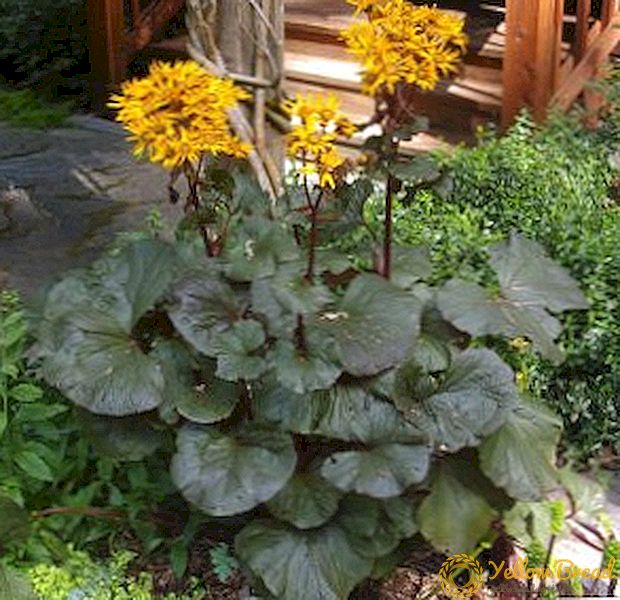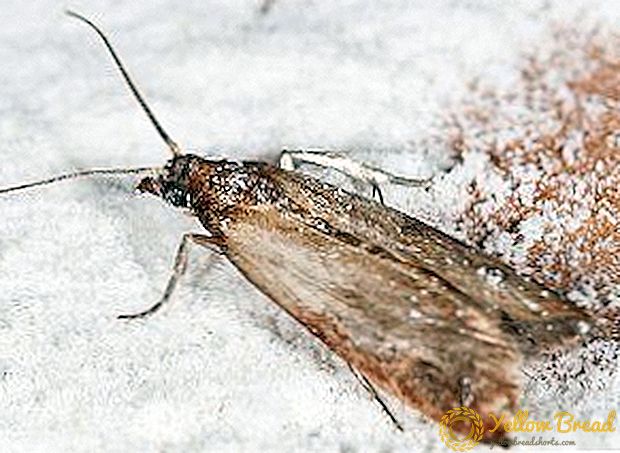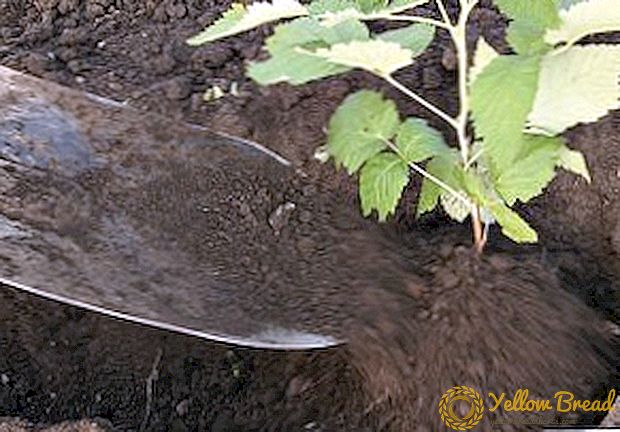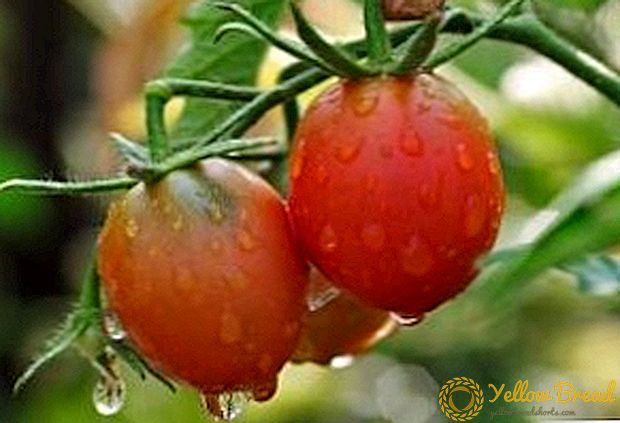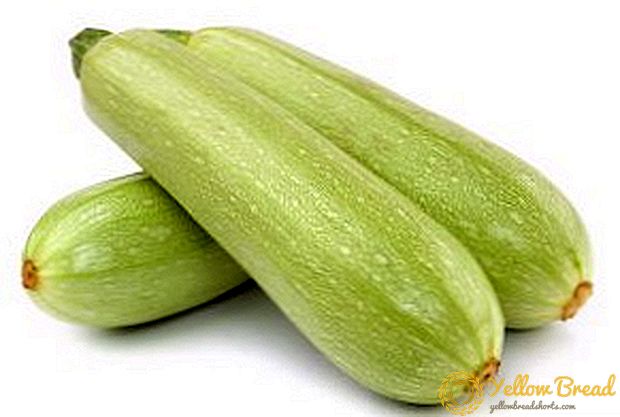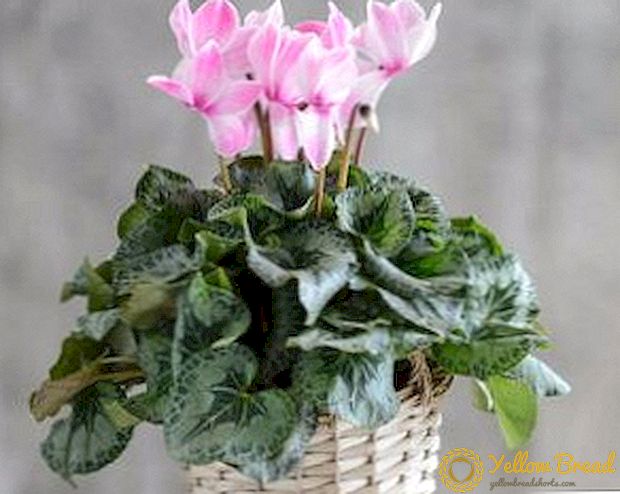 Cyclamen or dryakva is a perennial herbaceous plant of the subfamily Mirsinovye, family Primula. The birthplace of the flower is considered to be the Mediterranean coast, Asia Minor and Northeast Africa. Types of cyclamens have different names, which depend on the place where the flower grows. We will tell about some of them in more detail.
Cyclamen or dryakva is a perennial herbaceous plant of the subfamily Mirsinovye, family Primula. The birthplace of the flower is considered to be the Mediterranean coast, Asia Minor and Northeast Africa. Types of cyclamens have different names, which depend on the place where the flower grows. We will tell about some of them in more detail.
- Persian
- European
- African
- Alpine
- Colchis (Pontic)
- Greek
- Kossky
- Cypriot
- Neapolitan (ile)
Persian
Cyclamen persian (Cyclamen persicum) - a widespread plant in some countries of Asia, Africa and Western Europe (Sudan, Ethiopia, Italy, Cyprus, Iran).
This type of cyclamen grows comfortably in countries with moderately cold winters, for example, in northern Italy, even blooms in winter.
 The leaves of Persian dryak are heart-shaped, the color is dark green, and there is a marble-white pattern on the surface. Petals come in different colors: purple, white, red and pink.
The leaves of Persian dryak are heart-shaped, the color is dark green, and there is a marble-white pattern on the surface. Petals come in different colors: purple, white, red and pink.The plant stores a lot of organic and mineral substances in its tuber. During the inactive phase, it feeds on these substances. In the wild, if it blooms in winter, organic matter is especially needed.
Dutch breeders brought a lot of hybrids of Persian cyclamen. Hybrids have a longer flowering period.
European
Plant European cyclamen (blushing) is widespread in Central European countries (northern Italy, Slovenia, Macedonia).  It is a herbaceous evergreen plant with a flat-tuber (it is slightly flattened with a single point of growth).With age, the tuber of a flower is deformed and gives thick sprouts that have their points of growth.
It is a herbaceous evergreen plant with a flat-tuber (it is slightly flattened with a single point of growth).With age, the tuber of a flower is deformed and gives thick sprouts that have their points of growth.
The leaves of this species are dry basal with silver-green color. They have a heart-shaped shape with a pointed tip and a slightly jagged edge.
The underside of the leaves is purple-green. Five-petalled flowers, solitary, with very long peduncles. The petals are oval in shape and slightly twisted into a spiral. The peculiarity of the European dryakva is its sharp and delicate aroma.
Flowering continues throughout the growing season - from spring to autumn. The color of flowers is different: light purple, pale pink, bright purple, pink and purple.  Breeders have deduced several forms of European cyclamen, which differ in the flowering period and color of flowers.
Breeders have deduced several forms of European cyclamen, which differ in the flowering period and color of flowers.
The following varieties are popular with many gardeners: purpurascens (purple-pink flowers), carmineolineatum (white flowers), lake garda (pink flowers), album (white flowers).
African
Cyclamen is divided into different species and subspecies (varieties), but one of the most common and popular species isAfrican.
The shrub thickets of Tunisia and Algeria are considered the birthplace of African dryas. According to the botanical description, this plant species is similar to ivy cyclamen. There are two forms of African cyclamen: diploid and tetraploid.  The diploid form of African dryak has smaller leaves with different forms of petioles and more fragrant flowers. For decorative purposes, it is customary to use the diploid form of the African cyclamen.
The diploid form of African dryak has smaller leaves with different forms of petioles and more fragrant flowers. For decorative purposes, it is customary to use the diploid form of the African cyclamen.
The leaves of this plant are heart-shaped. The color is silver-green. African dryak leaves grow straight from the tuber, reaching length 15 cm.
This is one of the main differences of this plant species from ivy cyclamen. The plant blooms from spring to autumn, and young leaves begin to appear only in September-November.
The color of African Cyclamen flowers ranges from pale pink to deep pink.
This type of plant is afraid of frosty winters, therefore, requires a special shelter.The hot sun flower is also poorly tolerated (not in vain in North Africa, it is found only in the bush, where there is a lot of shade).
Alpine
Cyclamen alpine has a very vague history. At the end of the nineteenth century, Cyclamen alpinum was discovered and listed as a plant of the subfamily Mirsinovye.  But over time, some plants in the culture have disappeared, until 1956 Alpine Dryakva was considered an extinct species. The epithet "alpinum" has been used for a long time against the cyclamen intaminatium.
But over time, some plants in the culture have disappeared, until 1956 Alpine Dryakva was considered an extinct species. The epithet "alpinum" has been used for a long time against the cyclamen intaminatium.
There was a certain confusion in terms, the botanists decided to introduce a new name for alpine dryakva - cyclamen trochotherapy. This term is still used today by many scientists, although at the beginning of the 60s Davis confirmed that Cyclamen alpinum did not disappear.
At the beginning of the 2000s, 3 expeditions were sent to study this type of dryak.Expedition members confirmed that Alpine cyclamen is growing in the wild to this day.
The main difference of this type of plant is the angle of the flower petals (90º instead of the usual 180º). Petals are slightly twisted and look like a propeller.  The color of the petals varies from carmine-pink to pale pink with a purple-purple spot at the base of each petal.
The color of the petals varies from carmine-pink to pale pink with a purple-purple spot at the base of each petal.
The aroma of flowers is very pleasant and delicate, reminiscent of the smell of fresh honey. The leaves of the alpine dryak oval-shaped with a characteristic gray-green color.
Colchis (Pontic)
The Caucasus Mountains are considered to be the birthplace of this plant species. Colchis dryas also called pontic, caucasian or abkhazian.
At home it blooms from July to late October, in the wild - from early September to mid-October. Often found in the mountains at an altitude of 300-800 m among the roots of trees.  The flowers of Pontic dryak appear together with leaves. Petals are painted in dark pink color (darker at the edges), elliptical, slightly curved, 10-16 mm in length.
The flowers of Pontic dryak appear together with leaves. Petals are painted in dark pink color (darker at the edges), elliptical, slightly curved, 10-16 mm in length.
Tuber over the entire surface is covered with roots.The plant loves shady terrain with wet soil. The flower grows very slowly, but has a sharp and pleasant smell. Seed ripening takes a whole year.
At the moment, the number of this species is still quite large, but botanists claim that it is noticeably decreasing every year.
Greek
Greek Dryakva It is found on the mainland of Greece, the islands of Rhodes, Cyprus, Crete and on the coasts of Turkey. It is observed at an altitude of 1200 m above sea level. It grows in shady and wet places.
The leaves of this plant have the most diverse forms: ranging from heart-shaped and ending oval.
The leaf color varies from dark green to light lime with characteristic contrasting spots of cream or light gray.  The flowers of Greek cyclamen appear either before the leaves, or with them. The color of flowers varies from pale pink to carmine pink. At their base you can see bright purple spots.
The flowers of Greek cyclamen appear either before the leaves, or with them. The color of flowers varies from pale pink to carmine pink. At their base you can see bright purple spots.
In 1980, a rare subspecies of Greek dryak with white flowers was found on the Peloponnese peninsula; it was listed in the Red Book.
Kossky
In the Aegean Sea there is a certain island of Kos, in whose honor this species of cyclamen is named. The plant is found in the mountainous and coastal regions of Bulgaria, Georgia, Lebanon, Syria, Turkey, Ukraine and Iran.
Blooms Kosovo dryakva late winter or early spring. Foliage appears in late fall, and sometimes in winter.  Depending on the cultivar, the foliage can be either green or dark silver. The color of the flowers is different: pink, purple, red, white.
Depending on the cultivar, the foliage can be either green or dark silver. The color of the flowers is different: pink, purple, red, white.
The bases of the petals are always brightly colored. This type of flower is characterized by tubers with roots that grow only from below.
Observed certain patterns in the size of flowers,changes in the color of the petals and the shape of the leaves: light pink flowers and budlike leaves in plants from southern Lebanon and Syria, hot pink flowers characteristic of cyclamen from the northern coast of Turkey, further east the leaves are getting narrower, and the flowers are larger.
Heart-shaped leaves with large flowers are observed in southern regions of Iran and Azerbaijan.
Cypriot
Cyclamen Cypriot - One of the three plant species of the subfamily Mirsinovye, which are found on the island of Cyprus. Most often observed in the mountains of Kyrenia and Troodos at an altitude of 100-1100 m above sea level.
It grows on stone soils in bushy areas or under trees. Perennial plant, height 8-16 cm.  The flowers of the Cyprus dryakva pale pink or white color with a characteristic honey aroma. Purple or purple spots are observed at the base of the petals.
The flowers of the Cyprus dryakva pale pink or white color with a characteristic honey aroma. Purple or purple spots are observed at the base of the petals.
The leaves are heart-shaped. The color varies from dark green to olive. Cyclamen Cyclamen blooms from late September to mid-late winter. This flower is a symbol of Cyprus. As an ornamental plant is grown in many countries of the world.
Neapolitan (ile)
Neapolitan Cyclamen - One of the most common species of this plant in our country. Many gardeners call this flower "Neapolitan", and in scientific circles it is commonly called "ivy".  The first name (cyclamen hederifolium) was obtained in 1789, and the second (cyclamen neapolitanum) in 1813. In some garden centers under the guise of Neapolitan cyclamen you can sell a European one, referring to the fact that it is a subspecies cyclamen neapolitanum.
The first name (cyclamen hederifolium) was obtained in 1789, and the second (cyclamen neapolitanum) in 1813. In some garden centers under the guise of Neapolitan cyclamen you can sell a European one, referring to the fact that it is a subspecies cyclamen neapolitanum.
In order not to fall for the trick of the seller, you need to know the botanical description of the ivy blister.
The birthplace of the flower is considered the Mediterranean coast (from France to Turkey). Dryakva Neapolitan is considered the most frost-resistant type of cyclamen.
In the southern countries of Europe, this flower is used to decorate parks. On the territory of our country, ileum leafless dryas are used as indoor culture.
The name "Cyclamen Ivy" plant was obtained because of the shape of the leaf: rounded, green, with small grooves, like ivy.  The shape of the flower is very similar to the flower of European cyclamen, but there is a main difference: Neapolitan dryakva differs in small spectacular horns at the base.
The shape of the flower is very similar to the flower of European cyclamen, but there is a main difference: Neapolitan dryakva differs in small spectacular horns at the base.
The root system of the plant is superficial, and the flowers are only one color - pink. However, for decorative purposes, breeders have deduced many subspecies of this flower.
Some plants have a very small size (dwarf), flowering period in December-March, a very sharp and pleasant smell of flowers and color of petals.


